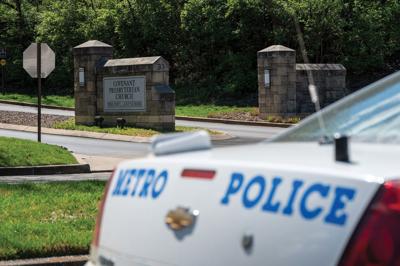Street View is a monthly column in which we’ll take a close look at issues affecting different neighborhoods throughout the city.

According to the Metro Nashville Police Department, as of this writing, 154 people have been shot in Nashville in 2023. Thirty-nine of those shootings have been fatal. Since the Covenant School shooting on March 27, the city has experienced nine other fatal shooting incidents and 33 non-fatal incidents. Gun violence is happening everywhere in the city: In the past three years, every Metro Council district — of which there are 35 — has seen at least one fatal shooting. The city experiences an average of roughly 11 shootings per district per year.
But this data doesn’t encapsulate the whole picture of how shootings occur throughout the city. While the data suggests that shootings are widespread, they happen much more frequently in some areas. Consider District 35, which encompasses Bellevue in western Davidson County. In the past three years, that district has had one fatal and two non-fatal shootings. District 17, which encompasses Wedgewood-Houston and Eighth Avenue, has experienced 134 shootings — 21 fatal and 115 non-fatal.
The two districts have slightly different populations — according to census data from the Nashville Chamber of Commerce, District 35’s population is 19,133, while District 17’s population is 20,138. But even accounting for the slight population difference, a person is still about 64 times more likely to be shot in District 17 than in District 35. Overall, the number of shootings in District 17 is nearly seven times the Nashville average.
District 17 isn’t the only district with disproportionately high numbers of shootings. Nashville has six districts with more than 60 shootings in the past three years, all with relatively high population density and all concentrated near the city’s downtown core: D2, D5, D6, D17, D19 and D21. Three of these districts (2, 17 and 21) have experienced more than 90 shootings in the past three years.
On the other end of the spectrum are five districts (D4, D8, D24, D34 and D35) with the lowest shooting numbers: eight or fewer total shootings in the past three years. Districts 4 and 24 have experienced four total shootings. District 35, Nashville’s safest in terms of gun violence, has experienced three.
While there are some overall trends, it’s difficult to conclusively predict where and why people will be shot. Still, Nashville follows nationwide trends suggesting that Black people are significantly more likely to be shooting victims. So far this year, the city has had 26 Black victims of fatal gun violence and 13 white victims. For non-fatal gun incidents, the numbers are 83 and 31 respectively, with one victim’s race listed as “other” on MNPD’s website. There are also about three times as many male victims as female victims.
Overall, the wealth of a district often correlates with its safety from gun violence. Recent census data shows that Nashville’s median household income is $65,565 and its average per capita income is $39,509. According to the Chamber of Commerce’s website, four out of the five safest districts have median household incomes (the income of everyone over age 15 in a given household) of at least $90,000. District 35, the safest, has a median household income of $105,000 and an average per capita income of $53,458. District 34, which had eight shootings in the past three years, has a median household income of $144,000 and a per capita income of $99,193.
In the districts with the highest numbers of shooting incidents, the wealth demographics are mixed. Districts 6 and 19 have median household incomes and per capita incomes above the Nashville average, while Districts 2, 5, 17 and 21 do not. And looking more closely at the data reveals some striking patterns — particularly the overlap between the Chamber of Commerce’s map of economic disparity and the MNPD’s gun violence map. In areas with higher poverty in Districts 6 and 17, for instance, more shootings occur. Overall, shootings in Nashville are widespread and not decreasing.
After the Covenant School shooting in March, students from across Tennessee rallied at the state Capitol to urge politicians to consider gun reform legislation, and the Tennessee Three used Rep. Justin Jones’ (D-Nashville) and Rep. Justin Pearson’s (D-Memphis) expulsion (and subsequent reinstatement) from the legislature to continue to bring national attention to gun violence issues. There are other local gun reform efforts. Kelley Griggs, a local tech entrepreneur, created a grassroots, bipartisan petition from the Nashville business community urging the legislature to enact extreme risk legislation designed to keep dangerous people from obtaining firearms. (Griggs co-wrote the petition with a few others, she says, but they wish to remain anonymous.) Even Republican Gov. Bill Lee supports extreme risk legislation. The petition currently has over 260 signatures.
Griggs says the letter advocates for extreme risk protection orders because that legislation covers both gun availability and mental health issues — causes of violence discussed on both sides of the aisle. “Other issues came up,” she says, “but these were the things that we all agreed could be first steps.” Recent polling suggests that the majority of Tennesseeans support strengthened background checks and red flag laws.
After the state’s Republican supermajority failed to address firearm legislation during its regular session, Gov. Lee signaled his intention to call a special legislative session on Aug. 21. Despite Lee’s call for state leaders to consider expanding existing risk protection laws, House Republicans released a statement saying they considered such legislation a “non-starter.” Recent polling suggests that the majority of Tennessee parents support expanded background checks and extreme risk protections.
If it does indeed take place, Lee’s proposed special session will begin three months after the publication of this story. If shootings continue at their current pace, about 14 additional Nashvillians will be killed by guns before the legislature convenes.
Editor’s note: The data for this piece was pulled on May 10, and some numbers may have changed since.






